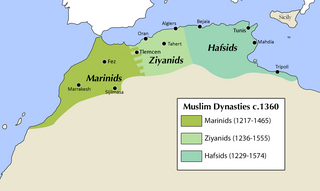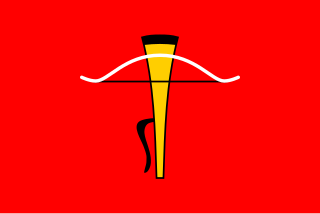Related Research Articles

The Almohad Caliphate or Almohad Empire was a North African Berber Muslim empire founded in the 12th century. At its height, it controlled much of the Iberian Peninsula (Al-Andalus) and North Africa.

The Hafsids were a Sunni Muslim dynasty of Berber descent who ruled Ifriqiya from 1229 to 1574.
Mongol ruler Ghazan Khan converted to Islam.

Abu Zakariya Yahya (Arabic: أبو زكريا يحيى بن حفص, Abu Zakariya Yahya I ben Abd al-Wahid was the founder and first sultan of the Hafsid dynasty in Ifriqiya. He was the grandson of Sheikh Abu al-Hafs, the leader of the Hintata and second in command of the Almohads after Abd al-Mu'min.

The Marinid Sultanate was a Berber Muslim empire from the mid-13th to the 15th century which controlled present-day Morocco and, intermittently, other parts of North Africa and of the southern Iberian Peninsula (Spain) around Gibraltar. It was named after the Banu Marin, a Zenata Berber tribe. The sultanate was ruled by the Marinid dynasty, founded by Abd al-Haqq I.

Battle of Alarcos, was a battle between the Almohads led by Abu Yusuf Ya'qub al-Mansur and King Alfonso VIII of Castile. It resulted in the defeat of the Castilian forces and their subsequent retreat to Toledo, whereas the Almohads reconquered Trujillo, Montánchez, and Talavera.

Abu Al-Hasan 'Ali ibn 'Othman, was a sultan of the Marinid dynasty who reigned in Morocco between 1331 and 1348. In 1333 he captured Gibraltar from the Castilians, although a later attempt to take Tarifa in 1339 ended in fiasco. In North Africa he extended his rule over Tlemcen and Hafsid Ifriqiya, which together covered the north of what is now Algeria and Tunisia. Under him the Marinid realms in the Maghreb briefly covered an area that rivalled that of the preceding Almohad Caliphate. However, he was forced to retreat due to a revolt of the Arab tribes, was shipwrecked, and lost many of his supporters. His son Abu Inan Faris seized power in Fez. Abu Al-Hasan died in exile in the High Atlas mountains.
Abū Yaʿqūb Yūsuf al-Mustanṣir was Caliph of the Almohads from 1213 until his death. Son of the previous caliph, Muhammad al-Nasir, the ten-year-old Yusuf was unexpectedly appointed heir by his father on his deathbed. He was confirmed as Almohad Caliph in election by the Almohad sheikhs after his father's death, and took up the caliphal title "al-Mustansir bi-Llah". Yusuf's mother was a Christian slave Qamar.
Abu Muhammad Abd al-Wahid 'al-Makhlu' was the Almohad Caliph for less than a year in 1224.

Abu Muhammad ʿAbdallah 'al-ʿAdil' was an Almohad Caliph, a former governor in al-Andalus who challenged and secured the murder of his predecessor, Abd al-Wahid I. His 1224 coup ushered in a period of instability that lasted well beyond his own death in 1227. He is often regarded as one of the most disastrous of Almohad caliphs. His coup divided the Almohads and set in motion the loss of al-Andalus and the eventual collapse of the Almohad state.
Yahya, also spelled Yehya, is an Arabic male given name. It is an Arabic form of the given name John, originally Hebrew Yohanan, i.e. primarily John the Baptist, who is known as Yahya ibn Zakariyya in Islam, and is considered a prophet in Islam. For this reason, Yahya is a comparatively common name in the Muslim world. The related Biblical name of Jehiah has the Arabic form Yaḥiyyā يَحِيَّى., having the same Arabic consonantal text as the name Yahya does.
Abu Yusuf Yaqub ibn Abd al-Haqq was a Marinid ruler of Morocco. He was the fourth son of Marinid founder Abd al-Haqq, and succeeded his brother Abu Yahya in 1258. He died in 1286. He was the son of Abd al-Haqq I and Oum el-Iman bint Ali el-Bethary, a Zenata woman. Some sources add her mother to be known as Oum el Youm and a daughter of a Zenata clan leader of the Tafersit region.
Abu Idris al-Wathiq, known as Abu Dabbus, was the last Almohad caliph who reigned in Marrakesh from 1266 until his death.

The Kingdom of Tlemcen or Zayyanid Kingdom of Tlemcen was a kingdom ruled by the Berber Zayyanid dynasty in what is now the northwest of Algeria. Its territory stretched from Tlemcen to the Chelif bend and Algiers, and at its zenith reached Sijilmasa and the Moulouya River in the west, Tuat to the south and the Soummam in the east.
Abu Muhammad Abd al-Wahid ibn Abi Hafs al-Hintati, or simply Abd al-Wahid, was the Almohad governor of Ifriqiya from 1207 to 1221 and the father of the first Hafsid sultan Abu Zakariya Yahya.
Abu Muhammad Abdullah ibn Abd al-Wahid, or Abdullah, was the second ruler of the Hafsid dynasty in Ifriqiya from 1224 to 1229.
The Battle of Faḥṣ al-Jullāb was fought on Thursday 15 October 1165 between the invading Almohads and the king of Murcia, Ibn Mardanīsh.
Abu Yahya Abu Bakr II was the Hafsid caliph of Ifriqiya from 1318 to 1346. He was the son of Abu-Zakariyya Yahya III, emir of Bejaia and grandson of Abu Ishaq Ibrahim I. Under his rule the former unity of the Hafsid domains was restored.

The Hafsids of Béjaïa were a dynasty of independent or autonomous emirs. They were a branch of the Hafsid dynasty that ruled from Tunis; at times they recognised the caliph in Tunis and at other times they ruled independently. Periodically there was also conflict between the two branches of the dynasty.
Abū Ḥafṣ ʿUmar b. Yaḥyā al-Hintātī, chief of the Hintata, was a close companion of Ibn Tumart and a shaper of the Almohad Empire greatly responsible for the unification of the Almohad corps. His grandson Abū Zakariyyāʾ Yahyā b. ʿAbd al-Waḥīd founded the Hafsid dynasty in Ifriqiya. He lived a long life and helped maintain ties between the Almohad movement's early revolutionary doctrine and its later dynastic period established by ʿAbd al-Muʾmin.
References
- ↑ Fromherz 2010, p. 108.
- 1 2 3 4 Viguera-Molins 2000, p. 3469.
- ↑ Buresi & Aallaoui 2013, p. 30n.
- 1 2 Deverdun 1986, p. 461.
- ↑ Idris 1986, p. 66.
- ↑ Deverdun 1986, p. 461-462.
- ↑ Viguera-Molins 2000, p. 3469-3470.
- 1 2 Deverdun 1986, p. 462.
- 1 2 Viguera-Molins 2000, p. 3470.